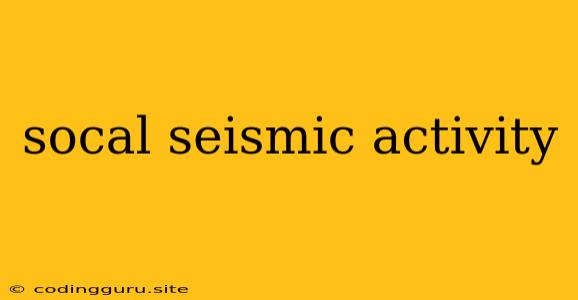Understanding Southern California's Seismic Activity
Southern California is known for its stunning landscapes, vibrant cities, and, unfortunately, its frequent earthquakes. This region sits atop the San Andreas Fault, a major geological feature responsible for much of the seismic activity experienced in the area. But what exactly drives these tremors, and what can we do to prepare for them?
Why is Southern California So Seismically Active?
Southern California is situated at the meeting point of the Pacific and North American tectonic plates. These massive plates are constantly moving, and their interaction along the San Andreas Fault is a primary source of earthquakes. Imagine two massive puzzle pieces rubbing against each other. This friction builds up energy, and when it's released, it causes the ground to shake.
The San Andreas Fault: A Major Player
The San Andreas Fault is a transform plate boundary, meaning the plates slide horizontally past each other. This type of fault is responsible for some of the most powerful earthquakes in the world. The San Andreas Fault runs for over 800 miles through California, with a significant portion running directly through Southern California.
Types of Earthquakes in Southern California
While the San Andreas Fault is the main culprit, Southern California experiences several types of earthquakes.
- Strike-slip earthquakes: These are the most common type in Southern California and are caused by the horizontal movement of the San Andreas Fault.
- Thrust earthquakes: These occur when one plate slides beneath another, like the Pacific Plate sliding under the North American Plate.
- Normal earthquakes: These occur when plates move apart, causing the ground to collapse.
What are the Risks?
The risks associated with seismic activity in Southern California are significant.
- Ground shaking: This is the most immediate danger of an earthquake and can cause buildings to collapse, roads to crack, and landslides to occur.
- Tsunamis: While less common in Southern California than on the Pacific coast of Japan, a major earthquake along the San Andreas Fault could trigger a tsunami, posing a significant threat to coastal communities.
- Liquefaction: This occurs when loose, saturated soil acts like a liquid during an earthquake, causing buildings and infrastructure to sink or tilt.
- Fire: Broken gas lines and electrical wires can ignite fires, adding to the devastation caused by an earthquake.
How Can We Prepare?
Southern California has a long history of earthquakes, and residents are encouraged to be prepared.
- Have an emergency plan: This should include a meeting place for family members, an emergency kit with food, water, first-aid supplies, and other essentials.
- Secure your home: Make sure heavy objects are securely fastened to prevent them from falling during an earthquake.
- Learn earthquake safety measures: Know how to drop, cover, and hold on during an earthquake.
- Participate in earthquake drills: Regular drills help you and your family prepare for the real thing.
- Stay informed: Monitor news and official sources for information and updates on earthquakes.
Conclusion
Southern California's seismic activity is a reality that residents must acknowledge and prepare for. Understanding the risks and taking proactive steps to prepare for earthquakes can significantly reduce the impact of these events. By staying informed and taking necessary precautions, we can minimize the danger and ensure the safety of our communities.
